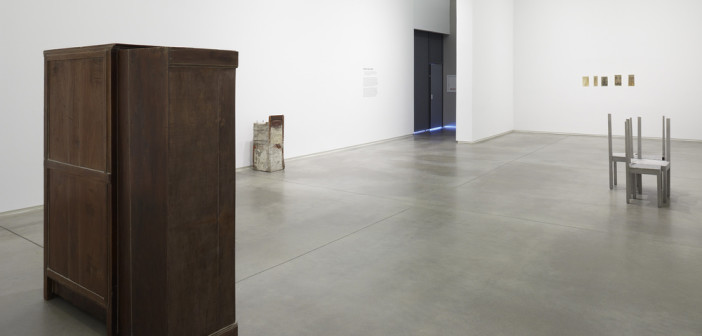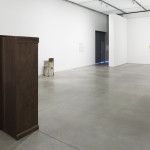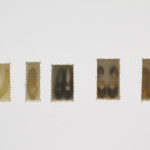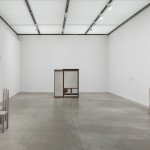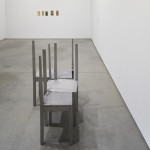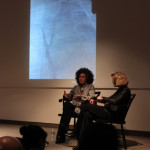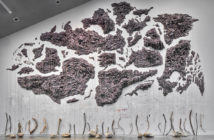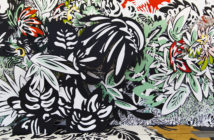Just before her lecture last Tuesday night at Harvard Art Museum, Doris Salcedo sat in the last row of a lecture hall in Sackler, starring off into space. She seemed unaware of the burgeoning crowd, lost in thought, present in some other time.
Salcedo, who lives and works in her native Bogotá, Colombia, was in town to give the concluding talk in this academic year’s "Art in Public Space" ArtisTalk lecture series. Infamous for large-scale public art pieces such as her installation at the 2003 Istanbul Biennial, in which she filled an empty lot between a row of city buildings with thousands of chairs, Salcedo’s works incorporate personal, everyday items once owned by victims of political violence in Columbia. As Mary Schneider Enriquez, Associate Curator of Modern and Contemporary Art at Harvard, observed in her introductory remarks, Salcedo’s talk was thus unfortunately appropriate in the aftermath of the Boston Marathon tragedy. "My work is the work of mourning," Salcedo told the crowd at Harvard. "There is nothing more human than mourning."
Salcedo emphasized how difficult she finds it to talk about her own work throughout her presentation, which underscored the power of art in addressing complicated and tragic themes such as pain and loss, violently inflicted. By obliquely discussing her work, which begins in the testimony of a victim of political violence, Salcedo highlighted how the political is always personal. Salcedo asserted that violence is the dominating ethos of our society, and that subconsciously or consciously, it’s present in our everyday lives. Her work strives us to remind us of that reality, and to externalize the inherently personal, internal experience of mourning that Jacques Derrida describes in The Work of Mourning. "Mourning marks a frontier we cannot penetrate, set apart from life by a line, a mark, a wound," said Salcedo after she read the audience a passage from the book. "And it is within these boundaries that I have tried to inscribe my work, marking specific sites for remembrance where acts of mourning could take place. I have devoted myself to making images of mourning, since images are all we’re left with once a beloved person has been taken away by a violent act."
As I listened to her, I began to understand why Salcedo was so composed, so seemingly far away in thought moments before she stood up to lecture. She was in another place, consumed by other another moment, which she could only live as a memory or a memory translated into an image. In listening to the testimony of someone whose loved one has disappeared, Salcedo keeps a distance, but is transfixed by the "memory of experience, always vanishing."
Salcedo closed her talk with images of her latest work, A Flor de Piel (2011-2012), a large shroud of sutured-together red rose petals which lies directly on the floor, forming a topography of undulating valleys and peaks. The petals are neither dead nor alive, but plucked from nature and artificially reconfigured, a gesture that mimics they way that the bereaved must learn to live with their dead. The petals are suspended in time, fragile and vulnerable to external forces, forming an object that will fade and recede with time. This shroud, which both marks and creates a space for mourning and the mourner, is an offering of flowers that allows us to memorialize the innumerable victims of political violence that we can never fully know.
"Violence is a display of ignorance," Salcedo said. "It doesn’t care, it doesn’t pay attention. As artists, we nee to be the opposite…we need to pay attention to every detail…to build an entire life." Approximately 200,000 people have died in the Colombian conflict; such an enormous number is abstract and intangible. Thousands die in gang and domestic violence, obscured through their regularity. Through their immediacy, their poignant re-contexualization of ordinary objects, Salcedo’s works bring the loss of human life to a human scale. Her works are quiet transgressions that articulate the sadness and senselessness of violence that happens across cultural boundaries in hopes that we remember, mourn and memorialize in our present. When someone from the audience asked about her emotional investment with this work, and how it effects her own happiness, she replied that she lives in mourning. "I think it’s important for us to all come close to these tragic events," she said. "It’s not happening in foreign countries, it’s happening right here." We are pushed to observe absence in Salcedo’s works, be visible or invisible to us, and to recognize the continued loss of human life through time, place and space.
- Installation at ICA, Photo credit: Charles Mayer.
- Installation at ICA, Photo credit: Charles Mayer.
- Installation at ICA, Photo credit: Charles Mayer.
- Installation at ICA, Photo credit: Charles Mayer.
- Doris Salcedo, Untitled, 2004—5. Stainless steel. Harvard Art Museums/Fogg Museum, Gift of Mr. and Mrs. John Cowles, by exchange, 2010.573. Photo: Harvard Art Museums, © President and Fellows of Harvard College.
- Courtesy of Harvard Art Museums.

